4. The impact of the Second World War on India
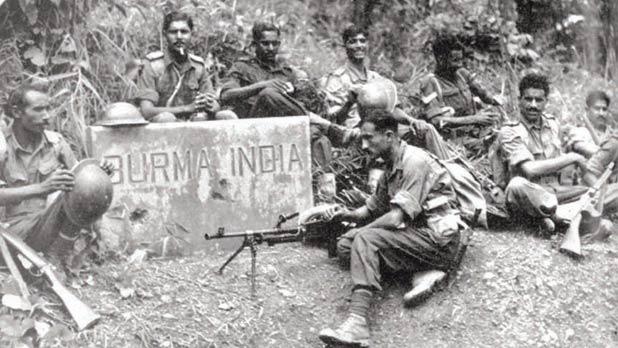
This page examines the impact of the Second World War on British rule in India and the growing divisions between Hindu and Muslim which would ultimately lead to Partition.
Guiding questions
What were the external threats to India from 1942?
To what extent could Subhas Chandra Bose be considered the ‘enemy within’?
Why did the Cripps Mission (1942) fail?
What was the impact of the 'Quit India' campaign?
In what ways was British power weakened by the end of the Second World War?
What were the results of the Indian elections of 1945 – 46?
What were the proposals of British Prime Minister Atlee’s Cabinet Mission in March 1946?
What was the role of Viceroy Admiral Louis Mountbatten in the partition of India?
Why did Jinnah unleash civil war in India in August 1946?
Why did Partition lead to carnage?
When was independence finally achieved?
1. What were the external threats to India from 1942?

The Allied position in the war looked bleak by 1942, as Hitler dominated Europe and his forces were in Egypt threatening control of the Suez Canal. Meanwhile Imperial Japan had moved through South East Asia taking control of key cities in China, Hong Kong, the Philippines, Malaya, Indochina and Thailand. Singapore fell in February 1942. For the British the fall of ‘unconquerable’ Singapore was a disaster. Churchill declared it as ‘the worst disaster and largest capitulation in British history.’ Japan had declared that its aim was to liberate all Asians from European control and the Malayans and Burmese had apparently welcomed Japanese troops as liberators. Japanese ships could now move with ease in the Indian Ocean. Viceroy Linlithgow announced in March that there were insufficient armed forces in India to resist a Japanese landing on the Cuttack coast and would be unable to prevent an advance on Orissa. His only desperate proposal was a policy of ‘scorched earth’ against a land invasion through Bengal.
Task One
ATL: Research and thinking skills
In pairs discuss the following questions:
- Investigate the fall of Singapore and why its loss was significant for Britain’s forces in Asia.
- Review the map and the material above. Why would Viceroy Linlithgow be concerned about Britain’s ability to resist a Japanese attack on India by March 1942?
- How might Congress and the Muslim League respond to a Japanese invasion of India?
2. To what extent could Subhas Chandra Bose be considered the ‘enemy within’?
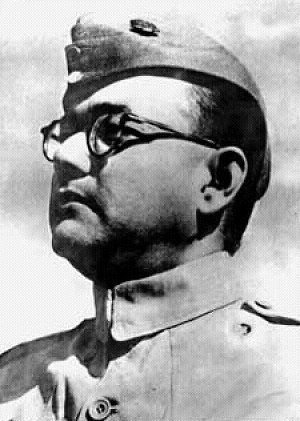
"Give me blood, and I shall give you freedom!" Subhas Chandra Bose 4 July 1944.
Task One
ATL: Research skills
In pairs briefly explore the background of Subhas Chandra Bose and his political career in India up to 1939, when he left the Congress Party.
After leaving the Congress Party Subhas Chandra Bose formed the Forward Bloc Party whose objective was to force Britain to quit India by any means. The Raj banned the party in 1941 and Bose went into hiding in Afghanistan but then ended up in Berlin where he received a rather unenthusiastic reception from Hitler who was concerned that a collapse in British control could lead to the Soviets moving in to India.
Bose was initially encouraged to give propaganda broadcasts to foster a rising against the British, and the Azad Hind [Free India] Radio service was set in 1942. Bose was then permitted to move to Japan to assist with a Japanese land invasion of India, and the headquarters of Azad Hind radio was moved to Singapore. In 1943, the Provisional Government of Free India [Azad Hind] was founded in occupied Singapore. In Japan, Bose formed the Indian National Army [INA] comprised of Indians taken prisoner of war by the Japanese. The INA was used for acts of sabotage behind enemy lines, but many Indians were arrested in India and some became double agents.
Bose urged for a full scale invasion, whereas the Japanese had more limited aims. Japan was engaged in a series of battles in the Burma Campaign. In the battles of Kohima and Imphal, in the spring of 1944, 6000 troops of the INA joined Japanese forces. In July 1944, in a speech broadcast on Azad Hind radio, Bose asked the ‘Father of the Nation’, Gandhi, for his blessing for the war he was fighting against the British.
Task Two
ATL: Thinking skills
Watch from 1.10 minutes in to tape and answer the questions below.
- When was the first time Anglo-Indian forces resist Japanese forces?
- What was the first attack on Indian territory?
- What would Japanese victory at Kohima and Imphal mean?
- What did the Allies have control of which meant reinforcements could be deployed?
- Why did the Japanese fail at Kohima and Imphal?
- What was left of ‘Bose’s dream of a victorious march to Delhi’?
- What did many members of the INA still believe after the defeat at Kohima and Imphal?
- What did it mean for the British-Indian Army?
- When did the Indian army meet the last fighting division of the INA?
As you have seen, the British-Indian army were able to defeat the Japanese and INA. 400 INA were killed, 1500 died from disease and 1400 were badly injured. 600 deserted and joined the British-Indian forces.
Bose, who had escaped on the last Japanese flight out of Rangoon, was killed when the plane crashed in Formosa. He survived the crash but subsequently died of third degree burns.
Task Three
ATL: Self-management skills
In pairs discuss the extent to which you agree that Bose had been the ‘enemy within’ during the Second World War.
3. Why did the Cripps Mission (1942) fail?
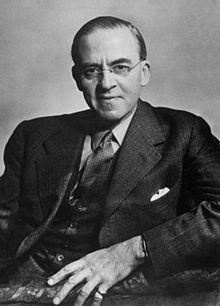
Sir Stanley Cripps. He was a member of the Labour Party, a friend of both Nehru and Gandhi and sympathetic to Indian independence.
In 1941, US President Truman and Prime Minister Winston Churchill had pronounced the Atlantic Charter. This affirmed that all people had the right to pursue self-determination after the war. However, Churchill went on to reassure the British parliament that this did not apply to India and other parts of the British empire. Jumuna Das Mehta highlighted to the Viceroy that Indians had therefore been dying for the freedom of others – the freedom denied to India. President of the All-India Hindu Mahasabha, Vinayak Savarkar, directly appealed to Roosevelt to guarantee India’s post-war independence. Once the US was fully engaged in the Second World War in both Europe and Asia, Roosevelt was committed to gaining the full support of India for the war effort. Although thousands of Indian troops were deployed on different fronts, the president was concerned about the internal situation in India.
- Roosevelt did not want India to fall to the Japanese
- Roosevelt did not want the war in Asia to be perceived as the US supporting British imperialism
The president attempted to put pressure on Churchill to agree to India’s self-government with a plan to unite the nation. Within the British War Cabinet, Clement Atlee and Leo Amery supported Roosevelt and argued that India’s security depended on the creation of a popularly mandated national government. Atlee suggested that this should happen immediately and could not wait until after the war. Churchill relented, and appointed Sir Stafford Cripps to lead a delegation to India.
Cripps offered the following: India would have full dominion status after the war; the Indian people would elect a new assembly which would draw up a new constitution; a province could separate itself from the new India if it wished.
In return Cripps wanted: all Indian parties to join an interim government of national unity under the Viceroy which would be in place until the end of the war.
Task One
ATL – Communication skills
Watch the following clip. What does Cripps say about his mission in 1942 and its failure in India?
Task Two
ATL: Thinking skills
Discuss the following with a partner:
How far was the failure of the Cripps mission a victory for Churchill?
Did the rejection of a ‘reasonable proposal’ by India’s parties demonstrate that Roosevelt did not fully understand the situation at the time?
4. What was the impact of the 'Quit India' campaign?
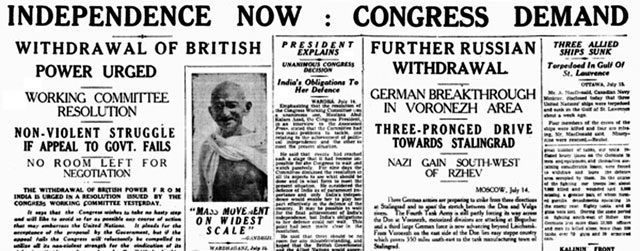
'We are now taking a step from which there will be no going back....It is going to be a fight to the finish. The Congress has now burnt its boats and is about to embark upon a desperate campaign'. Nehru
After the failure of the Cripps Mission, both sides hardened their positions. Congress took its lead from Gandhi who was now sure that the British no longer had the right to rule in India. With the very real threat of Japanese invasion, it seemed a perfect time to tell the British to 'Quit India' and Congress made a formal demand that Britain should pull out of India immediately at a meeting in Bombay on 8th August 1942. It threatened a major campaign of civil disobedience - what Gandhi called 'open rebellion' - should the British refuse.
Task One
ATL: Thinking skills
What point is Gandhi making here? What is significant about the language he is using?
There are powerful elements of fascism in British rule and in India these are the elements which we see and feel every day. If the British wish..to win the war and make the world better, they must purify themselves by surrendering power in India.
Task Two
ATL: Thinking skills
Read an account of the Quit India Campaign which can be found here (Smithsonian.com)
What were the key characteristics of this campaign?
Why, according to this article, did it gain such momentum?
The seriousness with which the British viewed the campaign can be seen in the message that Viceroy Linlithgow wrote to Prime Minister Churchill on 31 August:
I am engaged here in meeting by far the most serious rebellion since that of 1857, the gravity and extent of which we have so far concealed from the world for reasons of military security. Mob violence remains rampant over large tracts of the countryside. I am by no means confident that we may not see in September a formidable effort to renew this widespread sabotage of our war effort.
In fact, the British were much more prepared for this rebellion than they had been for the 1857 mutiny. By the end of 1942, the British had managed to suppress the Quit India movement, using 57 infantry battalions to restore order.
The campaign was a disappointment for Congress in terms of its original aims:
- Nearly 1000 people had been killed and 60,000 arrested (though Congress claimed that these figures were too low)
- The campaign had failed to paralyse the government; the military had remained loyal to the Raj
- The campaign had failed to attract support throughout India. Lawrence James writes that 'By no stretch of the imagination had the campaign been universal in terms of geography, caste or religion. Nor that matter, had been its predecessors in 1919 and 1920'.
Nevertheless, as James also stresses, '..each spasm of protest had severely shaken the Raj and added to the impression that it was losing the consent and goodwill of its subjects' (pg 571)
5. In what ways was British power weakened by the end of the Second World War?
Go to the video page and watch Niall Ferguson's Empire (Episode 6) to get an understanding of the impact of the war on Britain's empire: 7. Nationalism and Independence in India: Videos
Field Marshall Wavell was appointed Viceroy in June 1943 and he remained in place until 1947. By the end of the war in 1945, British power in India had been seriously weakened. Viceroy Wavell renewed the proposal made during the war by Cripps with the addition of a proposal for an Executive Council. The Council would give a balanced representation to Hindus and Muslims and only the position of Viceroy and the Commander-in-Chief would remain British. Congress was not happy with the notion of parity with the Muslims, and the inclusion in the proposal of the term ‘caste Hindus’ suggested that the untouchables would not be considered eligible.
A conference of Indian political leaders was held at Simla on 25 June 1945, including Gandhi, Nehru and Jinnah. Discussions were deadlocked over how Muslim leaders would be selected – Jinnah wanted the Muslim League to select whereas Congress, asserting it was an ‘inclusive’ party, asserted that Muslims should also represent its party. The conference ended in deadlock.
Task One
ATL: Thinking skills
‘The loss of India would be final and fatal to us. It could not fail to be part of a process that would reduce us to the scale of a minor power.’ Winston Churchill to House of Commons. February 1931.
In pairs read through the chart below. Discuss which factor might have been the most serious issue for the maintenance of British control in India.
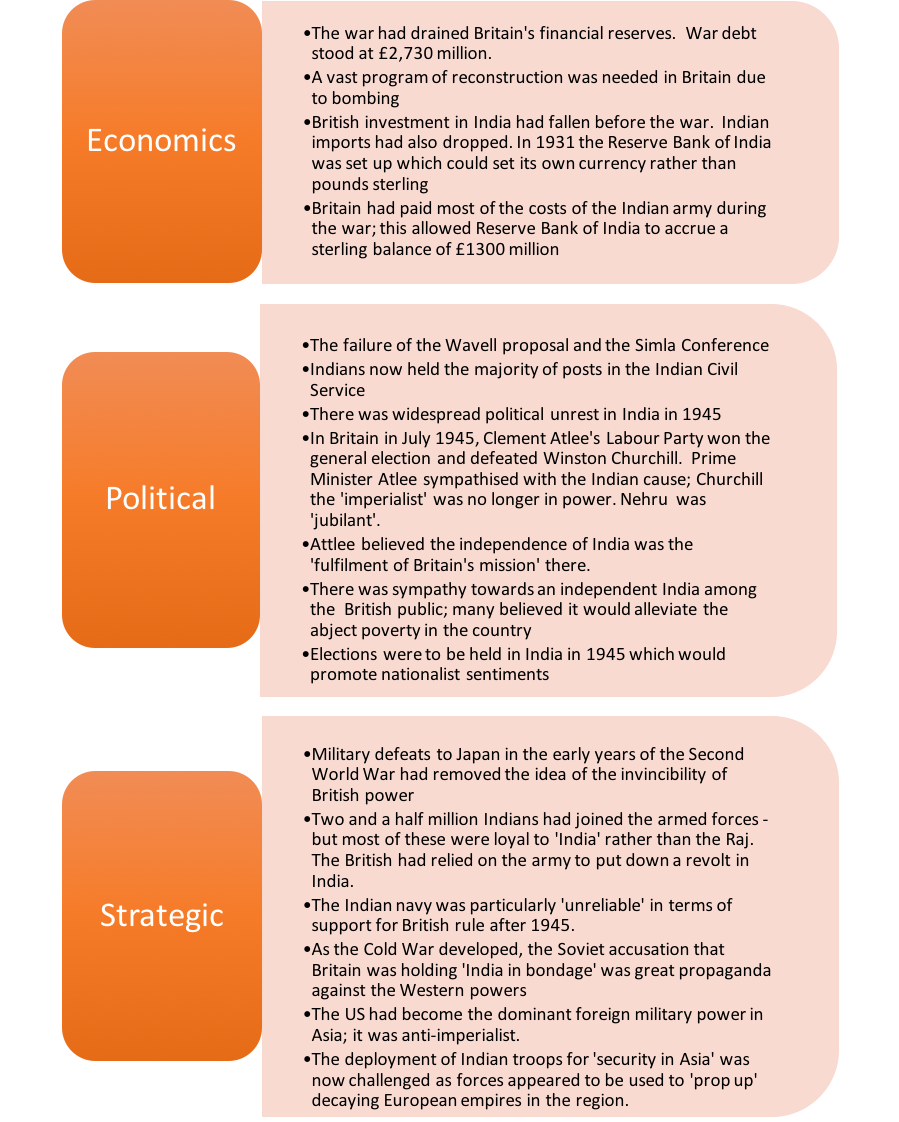
There is an essay frame on the impact of the Second World War here: 6. Nationalism and Independence in India: Essay planning
6. What were the results of the Indian elections of 1945 – 46?
To begin the process towards negotiations for a political settlement in India the British proposed that elections be held across India between 1945 and 1946 which would elect members to a constituent assembly.
During the election period there was widespread street violence and murder. There were 7 million demobilized men returning from the war looking for work at a time when war industries were making workers redundant. There were mutinies in the navy. In southern India a drought led to concerns about possible famine.
Congress won 90% of the seats, and the Muslim league won all 30 of the seats reserved for Muslims. Congress retained control of the United and Central Provinces, the North-West Frontier Province, Orissa, Madras and Bombay. The Muslim League had control in Bengal, the Sind and held 79 / 175 seats in the Punjab. The remaining 15 seats were won by Sikhs, Europeans and independents.
Task One
ATL: Thinking skills
In pairs look at the map below and discuss the implications of the results for the future of post-colonial India.
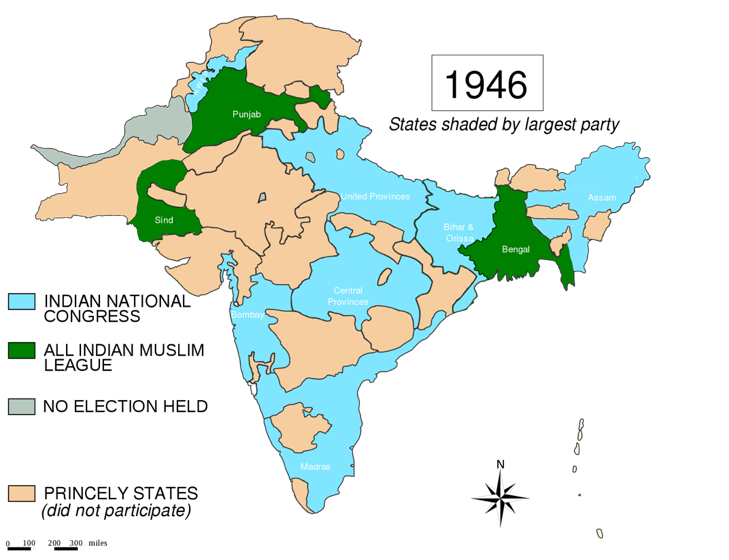
7. What were the proposals of British Prime Minister Atlee’s Cabinet Mission in March 1946?
The British Prime Minister Atlee instructed the mission that India must remain united. This was critical for ‘security in Asia’. Lord Pethick-Lawrence, Stafford Cripps and A V Alexander, known as the ‘three wise men’ headed the mission with the understanding that a united India seemed to exclude the possibility of a separate Pakistan.
Task One
ATL – Thinking skills
In pairs read through the chart below. The Cabinet Mission warned that these proposals might be the last chance for a peaceful transition of power, and warned that there could be ‘chaos and even civil war’ if it was rejected.
With your partner discuss how these proposals might have been received by a] Congress and b] The Muslim League.

Both Congress and the Muslim League accepted the proposal. Gandhi stated that the proposal meant that the British ‘would get off India’s back’ and that 'it contains the seed to convert this land of sorrow into one without sorrow and suffering'. The Muslim League accepted the proposals as they laid down the basis for a Pakistan state in the future. There had been no Sikh representation and limited attention was given to the potential vulnerability of this community. The Princes, who had treaties with the British, were also ignored.
Jawaharlal Nehru was then elected president of Congress. Following this, Nehru gave a controversial press conference on 10 July 1946 in which he suggested that once Congress was in control of the All-India Union it would act as it wanted; he predicted that the provincial grouping proposal would collapse as Hindus did not support them. Nehru envisaged a ‘Hindu Raj’ would be established and the notion of separate state of Pakistan would wither away.
Task Two
ATL: Thinking skills
In pairs read Nehru's statement which can be found here
Identify the key points in Nehru’s statement that would inflame tension and hostility with the Muslim League.
Information box: Jinnah was a sick man at this time, and there has been some speculation by historians that had Congress and the British known this and had slowed the pace of transition down, Jinnah may have then died and the momentum behind the establishment of Pakistan would have been lost.
8. Why did Jinnah unleash civil war in India in August 1946?
‘…we bid goodbye to constitutional methods. We have exhausted all reason. There is no tribunal to which we can go. The only tribunal is the Muslim nation.’
Jinnah. August 1946.
Jinnah was outraged at the apparent betrayal by Congress and Nehru, and also at the British whose Cabinet Mission had left India just as its proposals seem to have fallen apart. Jinnah called on the Muslim League to prepare for ‘Direct Action Day’ on 16 August 1946.
In Calcutta the police were given a ‘holiday’ and mobs took over the streets. 5000 people were killed in three days, 20,000 injured and 100,000 left homeless. This triggered the spread of murder, rape, looting and arson across India.
Viceroy Wavell was unable to control the escalating crisis as Jinnah declared that the death of 10 million Muslims would be a sacrifice worth paying for the establishment of Pakistan.
Task One
ATL: Research skills
Watch this video, 'The Day that India burned', from 11 minutes 45 seconds to 22 minutes.
1. What happened in Calcutta in August 1946?
2. What actions did the British take to deal with the riots?
3. What did the British and many Indians realise after the events in Calcutta?
4. What was Gandhi's attitude to the events that were now unfolding and what actions did he take?
5. Why was he unable to unify Muslims and Hindus?
9. What was the role of Viceroy Admiral Louis Mountbatten in the partition of India?
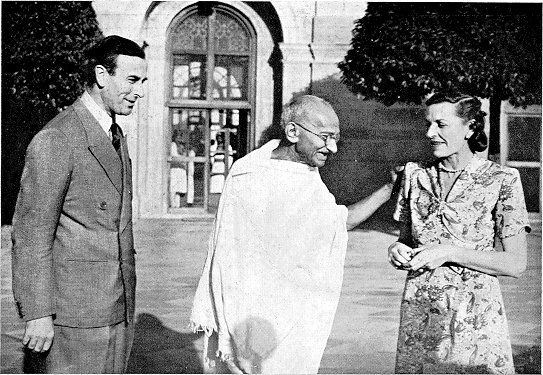
Photographs of the Mountbattens with Gandhi fostered the perception amongst Muslim’s that the viceroy was pro-Hindu and Congress.
Attlee removed Wavell at the end of January 1947 and replaced him with Louis Mountbatten with the brief to prevent the partition of India. The British House of Commons had voted to transfer power to India no later than 30 June 1948. If Congress and the League could not cooperate then the British would leave India in the hands of the central and provincial government.
As the Cold War developed after 1945, the British government was concerned of the potential of Soviet interference and influence growing in India. It was also believed that if a separate Pakistan was established it would need British protection from the USSR which could threaten it via Afghanistan.
Mountbatten was determined to gain a friendly working relationship with the key figures in Indian politics in order to broker an agreement for transition to independence. His charm enabled him to gain a good relationship with Gandhi and Nehru and Congress leaders. However, his initial meeting with Jinnah was not cordial, and the latter was not impressed with Mountbatten’s ‘charm offensive’. Jinnah was subsequently informed that Mountbatten referred to him as ‘evil’ and as a lunatic. Jinnah believed that Mountbatten was pro-Congress, and this perception was exacerbated by the obvious rapport between Nehru and Countess Edwina Mountbatten
‘But neither the persuasions of London, nor the shock of an imminent political vacuum, nor the stimulus of a new personality could now break the Congress-League deadlock.’ Percival Spear. Oxford History of Modern India. Page. 388
Against the wishes of Attlee’s government, after four weeks of consultation with Indian leaders, Mountbatten decided that Partition was the only solution for India.
Task One
ATL: Thinking skills
In pairs read through the chart below and discuss the reasons Mountbatten reached conclusion that Partition was necessary.

Historian’s viewpoint:
The Historian Stanely Wolpert suggests that Mountbatten was determined to bring a swift conclusion to the transfer of power in India as he saw his appointment as Viceroy to India as an interruption to his naval career.
Historian Lawrence James argues that Mountbatten’s decision to bring forward the transfer of power to 15 August, and the declaration that the Punjab was to be divided between India and Pakistan ‘added immeasurably to the turmoil.’
The initial ‘Balkan Plan’ was rejected by Nehru as he believed it would lead to civil war. The proposal envisaged each Indian state and province would have self-determination. The preview of the plan was not given to Jinnah, and this was seen as yet more evidence of partiality. The Final Plan was an attempt to keep Congress on side and to gain Jinnah’s support. Mountbatten was increasingly worried that the situation was spiraling out of control and a solution had to be found. His plan for partition, the Menon Plan or 3 June plan, was accepted by Congress, the League and Sikhs. The Sikhs were the least satisfied and some wanted to fight on.
Task Two
ATL: Thinking skills
Continue watching the video 'The Day India Burned' from 27 minutes in until 50 minutes and answer the following questions:
- In the Punjab what did the Sikhs want?
- What did events in the Punjab suggest about the religious divide in India as a whole?
- Why was a deal struck?
- What was to happen to The Punjab and Bengal?
- What did Mountbatten then decide and why?
- How was the boundary drawn up and how long did it take?
- Where was the task the most difficult?
- What factors were taken into account?
- Why were most British troops sent home in July 1947?
- What happened in Lahore?
- Why were the Princely States a potential problem? What decision was taken?
- Why did Mountbatten keep the border secret? What were the results of this?
On 15 July, the plan for the complete separation of India and Pakistan in exactly one month’s time was announced in the British parliament.
The boundary commission was given just 5 weeks to draw up a border between India and Pakistan. As you will have seen from the video above, this was an extremely difficult task. The work of the boundary commission was plagued with leaks and, in turn, pressure to revise the boundaries it was drawing up. Mountbatten was involved in pressuring the commission on the behalf of Nehru.
The case of Firozpur
The town of Firozpur was initially put on the Pakistan side of the boundary. After lobbying by Nehru and Congress, due to Firozpur’s significance - controlling the only bridge over the River Sutlej and irrigation system in the area, Mountbatten had dinner with the chairman of the commission Sir Cyril Radcliffe. The following day Firozpur was placed on the Indian side of the boundary.
Mountbatten was seen to be strengthening India at the expense of Pakistan. His motives for this may have been his personal dislike of Jinnah, but he also did not believe that an independent Pakistan was viable; it would be a temporary state that would fail and be absorbed back into India.
Officials also had to divide up the assets of British India between India and Pakistan, this was to be done on a ratio of 82.5% for India and 17.5% for Pakistan. Separation was complex and meant that the infrastructure and services had to be dismantled and redeveloped including:
- The civil service
- The military
- The police
- Railways
- Communication systems
- Schools
Task Two
ATL – Research skills
In small groups research further Mountbatten’s response to the fate of the Indian Princes that had supported British rule. Your group should include an investigation into the Nawab of Bhopal’s response to Mountbatten’s policies, the advice of Conrad Corfield and the conference of Indian princes of July 1947.
To what extent does your research suggest that the Indian princes should have been given more time by Mountbatten to prepare for the transition of power and Partition?
Task Three
ATL – Communication skills
Watch the following documentary, Last 40 Years of the British Empire in India from 36.00 to 46.01 and answer the questions that follow:
- What pledge was Prime Minister Attlee’s government committed to?
- What does Viceroy Wavell think about the new Labour government in Britain?
- What happened at the talks between Gandhi and Jinnah?
- When did Mountbatten arrive in new Delhi?
- What was his responsibility in India?
- What were Mountbatten’s first impressions regarding the transfer of power?
- Which Indian leader retreated from political life?
- Why did Mountbatten bring forward the transfer of power to August?
- How many days did Mountbatten give Britain to leave India?
- What happened in the Punjab after British rule ended on 15th August 1947?
- Between August 1947 and March 1948 how many million Hindus and Muslims attempted to migrate to India or Pakistan?
- How many people were displaced and how many were killed in partition?
10. Why did Partition lead to carnage?
.png)
‘Partition…was one of the twentieth century’s darkest moments. The millions of people killed and forced to leave their homes merit greater recognition and a place closer to the heart of history writing for their own sake. The Partition of 1947 is a reminder…of the dangers of colonial interventions and the profound difficulties that dog regime change.’ Yasmin Khan – The Great Partition. 2017. Yale University.
Hindus, Muslims and Sikhs were terrified that, after 15th August, they would find themselves on the wrong side of the boundary. The situation for 6 million Sikhs was complex and dangerous as many resided in the Punjab where their holy city of Amritsar was located. Relations between Sikhs and Muslims was not cordial. Millions left their homes, land, businesses and property and traveled to either Indian or Pakistani territory. Approximately 10 million people attempted to move across the new boundary lines; at least 1 million people were butchered en route.
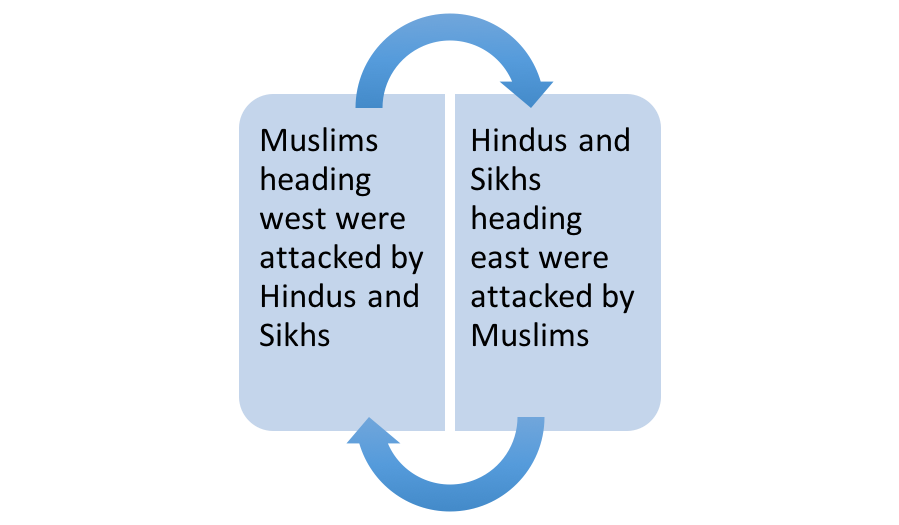
Task One
ATL: Research skills
In groups investigate further the events and tragedy that occurred during Partition, in what Larry Collins and Dominique Lapierre term ‘the greatest migration in history.’ You should include the response of Mountbatten, Congress and the League to the violence. Create an academic poster or display that documents this period.
As part of this investigation, continue watching the video 'The Day India Burned'. Also use the documents that can be found in the UK National Archives (see Task Three below)
This is also a very good podcast on the events of Partition
Travels Through Time #7 – Aanchal Malhotra, 1947 | History Today (www.historytoday.com)
In this episode we travel to the summer of 1947 to witness the chaotic, catastrophic sequence of events surrounding Indian independence and the subsequent Partition.
Task Two
ATL: Thinking skills
In pairs read the source below and discuss what it reveals about the response of Mountbatten to the violence unleashed by Partition.
At the opening meeting the committee got a stunning glimpse of the toughness of which Mountbatten was capable. If the security guards on trains failed to open fire on their assailants, he had a solution to propose. Any time a train was successfully attacked, Mountbatten said, round up its security guards. Sort out those that were wounded. Then court-marital and shoot the rest on the spot. That, he told the meeting, would have a salutary effect on the guards' discipline.
Extract from the book Freedom at Midnight by Larry Collins and Dominique Lapierre. Harper Collins. 1997. Page 401.
Task Three
ATL: Thinking skills
The UK National Archives has many primary sources relating to the events leading up to Partition.
Work in pairs and choose one source. What does your chosen source reveal about the events and attitudes of the time?
With reference to origin, purpose and content, evaluate the value of your chosen source to a historian studying Partition.
11. When was independence finally achieved?
Mountbatten’s plan on 3 June 1947 had provided for the establishment of a separate India and Pakistan. The provinces of Bengal and Punjab were to be partitioned. The Indian Independence Act was passed by the British parliament in July 1947.
In the final days prior to independence, Jinnah had traveled to Karachi on 7 August. On 14th August, Jinnah was declared the Governor General of Pakistan.
Close to midnight on the same day, Nehru addressed Delhi’s constituent assembly:
At the stroke of the midnight hour, when the world sleeps, India will awake to life and freedom. A moment comes, which comes but rarely in history, when we stop out from the old to the new, when an age ends, and when the soul of a nation long suppressed, find utterance.
Task Three
ATL: Thinking skills
In pairs read the source below and discuss what it reveals about the response of the people of India to independence on 15 August 1947.
‘His [Nehru’s] poetic words… reminded people that their angry bewilderment today was not the only truth. There was a greater truth – that of a glorious struggle, hard-fought and hard-won, in which many fell martyrs and countless others made sacrifices, dreaming of the day India would be free. That day had come. The people of India saw too, and on 15 August – despite the sorrow in their hearts for the division of their land, danced in the streets with abandon and joy.’
India’s Struggle for Independence. Bipan Chandra, Mridula Mukherjee, Aditya Mukherjee, Sucheta Mahajan, K N Panikkar. Penguin. 2016. Page 504.
The British left India on 15th August. Mountbatten became Governor General of India. Gandhi did not stay in Delhi for the independence celebrations – he left for Bengal. He wrote: ‘We … have not taken the trouble to rectify the errors of the past’
After independence, India and Pakistan were able to sign treaties with the princely states. All but three of these states had acceded to the Indian Union – Janagadh, Hyderabad and Kashmir resisted.
Task Four
ATL: Thinking skills
In small groups identify and discuss the points made by the historians in Source A through Source D.
Source A Yasmin Khan. The Great Partition. 2017. Yale University.
‘Partition is a lasting lesson of both the dangers of imperial hubris and the reactions of extreme nationalism.’
Source B Barney White-Spunner. Partition. 2017. Simnon and Schuster.
‘It could have ended so much better, as with British involvement in many other parts of the globe, had it ended when it should have done, when the age of empire was demonstrably over and when subject peoples were demanding self- government. It did not and when it was finally forced to close it did so amid terrible bloodshed, which the British and British Indian armies could have significantly limited if not wholly prevented.’
Source C Stanley Wolpert. Shameful Flight, The last years of the British Empire in India. OUP. 2006.
In… 1947 the world’s mightiest modern empire… abandoned its vow to protect one-fifth of humankind… I believe that the tragedy of Partition might well have been avoided… or at least mitigated, but for the arrogance and ignorance of a handful of British and Indian leaders. Those ten additional months of postwar talks, aborted by an impatient Mountbatten, might have helped all parties to agree that cooperation was much wiser than conflict…
Source D Lawrence James. Raj: The making and unmaking of British India. Little Brown & co. 1997.
Quite simply the last Viceroy lacked the prestige, authority and resources of his predecessors and, therefore, placed himself in the hands of those who possessed all these assets – Nehru and the Congress high command. He found them congenial partners and performed his duties according to his lights: the trouble was that he had too much to say for himself and no humility.
Task Five
ATL: Research and Thinking skills
In the same groups research different perspective on the reasons for a] the achievement of independence in 1947; b] the partition of the South Asian subcontinent in 1947.
Task Six
ATL: Self-management skills
Add the events on this page to the timeline that you started on the first page of this topic.

 IB Docs (2) Team
IB Docs (2) Team
